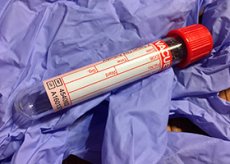General analysis of blood during pregnancy
Last reviewed: 23.04.2024

All iLive content is medically reviewed or fact checked to ensure as much factual accuracy as possible.
We have strict sourcing guidelines and only link to reputable media sites, academic research institutions and, whenever possible, medically peer reviewed studies. Note that the numbers in parentheses ([1], [2], etc.) are clickable links to these studies.
If you feel that any of our content is inaccurate, out-of-date, or otherwise questionable, please select it and press Ctrl + Enter.

The general analysis of blood during pregnancy is the simplest analysis that is prescribed for all future mothers. The main indicators of this analysis give information about the percentage of blood in the blood containing platelets, erythrocytes, leukocytes, the level of hemoglobin and ESR. It is these indicators that speak about the state of health of the pregnant woman and how the bearing of the fetus takes place.
According to the general analysis, one can learn about the hidden inflammatory process in the body, the beginning of anemia, allergies, helminthiases and other changes that affect the percentage of the formed elements in the blood. This is the easiest and fastest method of diagnosing physiological changes at an early stage. For pregnant women, such norms are established for the general analysis of blood:
- The norm of hemoglobin is 120-150 g / l.
- The norm of leukocytes is 4.0-9 n 10 9 cells / liter.
- The norm of erythrocytes is 3.5 -4.5 per 10 12 cells / liter.
- The norm of platelets is 150-380 at 10 9 cells / liter.
- The rate of ESR during pregnancy is up to 45 mm / h.
To give the general or common analysis of a blood at pregnancy it is necessary not less often three times throughout all pregnancy. The first time a woman becomes registered, then on the 20th and 30th weeks of gestation. Blood is better to take in the morning, before using for breakfast light meals.
Who to contact?
Explanation of blood test during pregnancy
The interpretation of the blood test during pregnancy will provide information on the rates and deviations. The norm is considered to be the fluctuation of hormonal balance and formed elements in the blood. Glucose is normal during pregnancy, remains at an unchanged level, sometimes slightly rising or falling - this is due to the hormones that are produced by the placenta.
Increased iron intake during pregnancy (lower serum ferritin and iron in the blood) can trigger the development of anemia in pregnant women. In addition, the level of vitamins and minerals decreases. Especially the need for calcium and phosphorus is increasing, in some cases acute calcium deficiency accompanied by hypoproteinemia can develop.
The number of platelets can vary at different periods of pregnancy, depending on the physiological characteristics of the organism of the future mother - 150-380 per 10 9 per liter. Erythrocytes in the blood of a pregnant woman are normally contained in the range 3.5-4.5 by 10 12 cells / liter.
The number of white blood cells in the total blood test during pregnancy can increase to 15.0 by 10 9, and many leukocytes accumulate in the body of the uterus in order to minimize the probability of infection to the fetus. The rate of erythrocyte sedimentation is also increased, while for pregnant women the indices are up to 45 mm / h.


 [
[